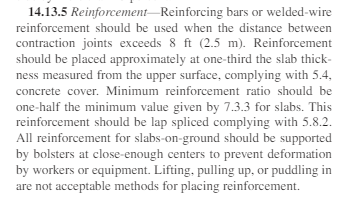medeek
Structural
- Mar 16, 2013
- 1,104
For residential work (slab-on-grade foundations, garage slabs etc...) I usually call out a 4" or 6" thick slab reinforced with 6x6-W2.9xW2.9 WWM. However, after some recent reading I'm beginning to think that rebar slab reinf. may be better for a number of reasons. One of which is how do you actually get out on a mesh reinf. slab without stepping all over the mesh, bending it and pushing it to the bottom of the slab even it is supported by chairs or dobies?
Perhaps a better option would be #3 bars at 18" o/c or #4 bars at 24" o/c, at least workers can step around the bars.
A confused student is a good student.
Nathaniel P. Wilkerson, PE
Perhaps a better option would be #3 bars at 18" o/c or #4 bars at 24" o/c, at least workers can step around the bars.
A confused student is a good student.
Nathaniel P. Wilkerson, PE


